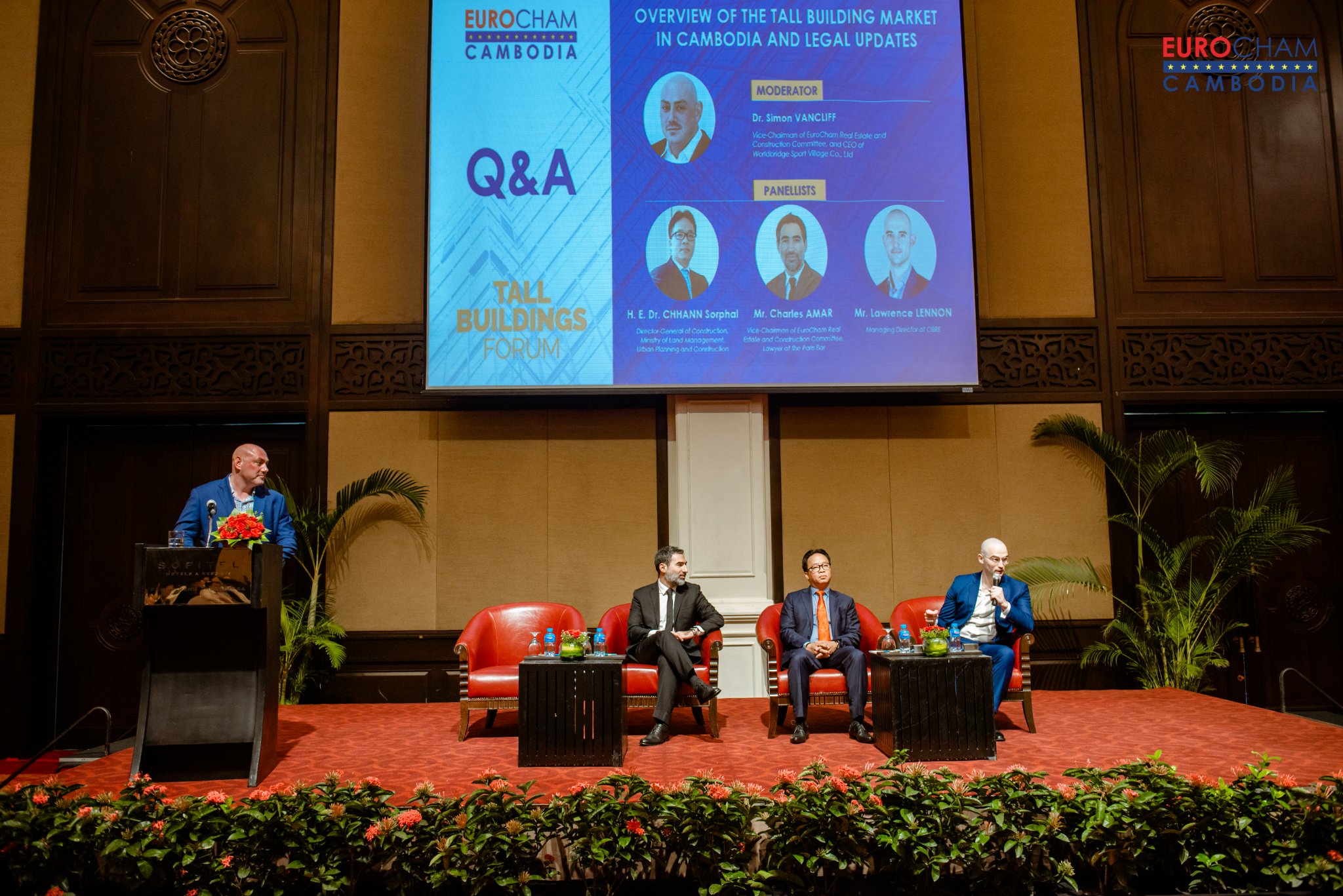The European Chamber of Commerce organized a successful return of the Tall Buildings Forum on Wednesday at Sofitel Phnom Penh Phokeethra, with experts forecasting the future of Phnom Penh, where exploding growth and sustainability will hopefully march forward hand-in-hand.
H.E. Dr. PEN Sophal, the secretary of state at the Ministry of Land Management, Urban Planning and Construction (MLUPC), opened the forum and asked for developers to keep Khmer culture, tradition, and architectural styles in mind when designing new buildings.
“I would like to call on real estate developers, builders, project designers, as well as construction managers to pay close attention to the spirit of national culture in their architectural works. They should prioritise sustainability and green development in compliance with regulations on urban planning, construction, and the environment. They should take responsibility for the development and preservation of national identity with Khmer culture and civilization, and the noble tradition of our nation,” he said.

Director-General of the ministry’s General Department of Construction, H.E. Dr. CHHANN Sorphal, presented next and provided an overview of the 2019 Law on Construction and recent relevant sub- decrees in the sector.
Tall buildings (defined as 12 stories by the MLUPC and 18 stories by commercial real estate firm CBRE) have a short history in the Kingdom, with 32-storey Canadia Tower being the first to be built in 2005. Bauer Special Foundations (Cambodia), represented at the forum by Director Shahzad Khurram, is currently involved in the planning of the 62-storey Sunwah Pearl Phnom Penh, set to be the tallest in Phnom Penh when completed.
Challenges in Tall Buildings
While optimism in the sector rebounded a bit as Covid largely receded, Lawrence Lennon, the managing director at CBRE, warned stakeholders to take a cautious approach against the backdrop of rising inflation, the Russia-Ukraine war, and geopolitical issues suppressing the global economy. He said the economy could be in the “eye of the storm” with a threatening global recession on the horizon and noted that material costs for developers had risen by approximately 20 to 30 percent since the start of Covid. Lennon added that a shift towards catering to the domestic market would be a wise choice for stakeholders in the industry.
“Phnom Penh has transformed into an almost unrecognisable city, raising questions about sustainability, construction quality, health and safety, and the economic viability of tall buildings in the face of oversupply,” he said.
“We as real estate construction and urban development professionals have a great honour to shape the future of the city and in turn, the lives of its habitants. We must work together to make Phnom Penh a thriving, healthy, and interesting place to call home. The private and public sectors must collaborate to encourage the diversification of the Cambodian economy, increase sustainability, and create a more livable, unique urban environment.”
Positive Outlook for Cambodia’s Tall Buildings
Saibal Das Chowdhury, the co-founder and CEO of Urbanetic, who was visiting from Singapore, said in his speech that utilizing big data and digital master planning could help Phnom Penh develop in a sustainable manner.
“The government’s role is very important to building a sustainable future,” he said
Among the key priorities he said, were protecting life, supporting green energy, keeping cities cool, and monitoring and preserving the natural environment.
Speaking on sustainability, Managing Director of BEE Incorporations Dr. Susanne Bodach outlined different environmental certifications available and advocated for the implementation of new tech to monitor and control indoor environments.
For example, she said 90 percent of a building’s operating costs are accounted for by staff, but the often poor air quality found in indoor environments can greatly reduce productivity. Meanwhile, two-thirds of a typical tall building’s operation costs are consumed by cooling systems.
Vannak Seng, the general secretary at Phnom Penh Capital Hall, said he was working with Bodach to help map a more sustainable Phnom Penh. He added that the city incorporated its first master plan in 1932 and was designed with the help of French nationals for a population of 300,000. Since that time, the city’s population has grown immensely and needs have changed, he said.

Property Management Needed for Tall Buildings Development
To close the forum, Managing Director at The Mall Company Simon Griffiths moderated a panel on the challenges and risks of property management. The panel agreed that regulation was needed regarding service charges to uphold proper maintenance in tall buildings.
Jovanny Antonio, the managing director of DA&G Real Estate Investment Management, said as occupants skimp on property management costs and push maintenance projects down the road in favor of quick profits, the values of these properties drop.
Ratanak Siv, the senior manager of property management at Urbanland Asia Investment added: “If your building is Grade A, but your management service is a C or C-, the customer service isn’t great, the common areas and common facilities aren’t well maintained, who wants to live in the building? That’s why property management plays a very important role.”
